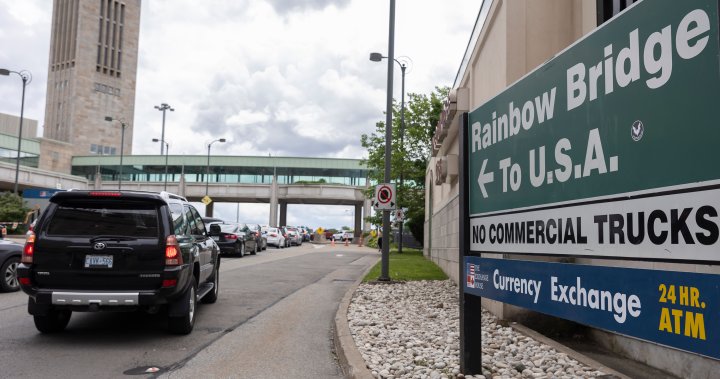World
After an epic year of wildfires, Canada’s air isn’t as clean as it used to be | CBC News

Canada’s record-setting wildfire season hiked the country up global pollution rankings — and for the first time made its air quality worse than the U.S., according to a new report by air quality technology company IQAir.
“In previous years, Canada had the cleanest air quality in all of North America,” said Glory Dolphin Hammes, CEO of IQAir’s North American division.
“This year we saw just the exact opposite. Our top 13 most polluted cities [in North America] are actually in Canada.” Fort McMurray and Peace River in Alberta, along with Yellowknife, took the top three regional spots.
As the climate warms, priming conditions for longer and more intense wildfire seasons, experts say protecting our air quality will be critical to our health and development.
The report measured annual average concentrations of fine particulate matter designated as PM2.5 — linked to numerous health issues — from more than 30,000 air quality monitoring stations around the world.
It then compared those amounts to the World Health Organization’s air quality guidelines.
Only 10 out of 134 countries featured in the report fell into that acceptable range.
Canada ranked 93rd, with an annual average PM2.5 concentration of 10.3 micrograms per cubic metre of air (μg/m³) — considered two to three times beyond the WHO’s recommended level.
The more populous U.S., for comparison, had an annual average concentration of 9.1. Daily and hourly amounts were not included, but it’s worth noting some Canadian cities crossed PM2.5 concentrations many times higher on particularly smoky days.
Sarah Henderson, scientific director of Environmental Health Services at the B.C. Centre for Disease Control (CDC), says it adds uncertainty to the gains made on air quality in North America.
“We’ve reduced what cars can emit, we’ve reduced what industry can emit and you see these air quality improvements,” Henderson said. “Wildfire smoke is a wild card. We don’t get to regulate that.”
Small size, big impact
PM2.5 refers to particulate matter that’s less than 2.5 microns in diameter. For context, the width of a human hair is around 75 microns.
“These are really, really small particles,” explains Sumil Thakrar, environmental scientist at the University of Minnesota. Wildfires spew these particles out and their small size allows them to travel far — and deep.
“When you breathe them in, they can deposit deep into your respiratory system and they can actually pass from your lungs into the bloodstream,” said Thakrar.
PM2.5 is a well-known health risk, and beyond inflaming and irritating the lungs, experts say it can cause cardiovascular issues like heart attacks and strokes as well as potentially long-term and short-term neurological issues.
A new report says heavy wildfire smoke made Canada’s 2023 air quality worse than the U.S. for the first time, and scientists warn it could happen again this year.
“The really important thing to keep in mind is that there’s no safe amount of particulate matter to inhale,” says Dr. Anne Hicks, pediatric respirologist at Stollery Children’s Hospital in Edmonton.
Hicks works with children with severe asthma and allergies, but they’re not the only ones at risk during smoky days from intense wildfires. She notes children tend to be more active, and their physiology means they have a faster breathing rate.
“A kid sitting still will breathe in more chemical particles than an adult who’s sitting still,” Hicks said.
‘Like an elephant sitting on my chest’
Sitting still indoors is not where Payton Knight wants to be. Her mom, Alyssa, says the 12-year-old loves the outdoors and being with the animals on their farm southeast of Edmonton. Last year’s wildfires made it harder.

“It reeked,” described Payton, who lives with complex asthma and allergies. “It’s like an elephant sitting on my chest. It gets harder and harder for me to breathe every time.”
Alyssa said she noticed a problem when Payton would ask for her rescue inhalers more often, just to get a few hours of relief at a time.
“And it came to a point where I had to be like ‘OK, no more going outside, we have to stay inside’,” Alyssa said. While she and Payton have “backup plans to backup plans” when it comes to her health, they are still nervous about this year — especially an upcoming family wedding in B.C. that’s potentially outdoors.
“Something that everyone looks forward to like going to their aunty’s wedding and being a part of that…. It’s now, because of our current climate, turned into something nerve-racking.”
Plan ahead for smoky days and weeks
Hicks advises patients, parents and schools to develop action plans for smoky days — including moving recess indoors, rearranging schedules for outdoor sports and getting kids used to wearing personal protection like masks. The long-term value of kids avoiding particulate exposure is high.
“We’ve shown that when air quality improves and when pollutants go down, kids grow stronger, healthier, bigger lungs,” Hicks told CBC News from her office in Edmonton, “And they have better lung function, and that lasts a lifetime.”
Henderson at the B.C. CDC says since everyone is exposed, efforts and interventions to improve air quality can have profound effects.
“You can make really big gains by actually making small changes that improve the air everyone is breathing.”
One of the tools Canadians can use to know about air quality in their area is the Air Quality Health Index, or AQHI. It measures PM2.5 as well as two other pollutants, nitrogen oxide and ozone, combining the risk into a score out of 10.
But Amy Li, air quality researcher and assistant professor at the University of Waterloo, says it shouldn’t be the only measure you rely on to gauge personal risk.
“You only have one to two air quality stations per city,” Li said. “So even if you see the numbers from the nearest weather station, it may not be a good representation of the exposure you’re getting.”
Both Hicks and Li advise using your senses as well. If it looks hazy and smells like smoke, these are good signs to tell if you’re getting exposed to higher than safe amounts of particulate matter. Li also suggests that better air filters for your ventilation systems can help on smoky days you’re forced to be indoors with the windows closed.
“Take actions now,” Li told CBC News from Kitchener, Ont. “I think it may be a little bit late if we only start to react during the wildfire smoke. I think now is a good time to make improvements to your existing systems [and] find the right filters.”
Millions of people are under air quality advisories as wildfire smoke blankets large parts of Canada and the U.S. About That producer Lauren Bird explores how it affects your health — and what you can do to protect yourself.











